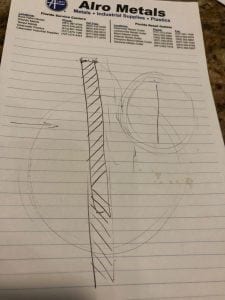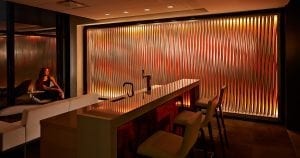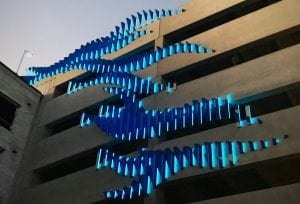May 18. . . Duck, Burlesque and Doors
I get a new draft of The Burlesque Astronomy Play onto the New Play Exchange and off to my Phoenix Theatre director and dramaturg this week.
And Skype into the first table read of Duck, at Miami’s City Theatre. It’s a table read of the entire show, all nine short plays. In a sea of action and hilarity, Duck is a quiet, quirky moment where the audience can catch their breath.
City Theatre treats playwrights wonderfully, and all the playwrights are invited to listen in from around the country to an excellent and amazingly versatile cast, all playing many parts.
This week Helen Hansen French and Alex Jones and I meet with sculptor Mark Aeling about Doors, a wordless short play I wrote for them about getting past differences and fear. It’s written for collaboration with visual artists. So we asked Mark, “Can you build us a wall? A wall that rotates, and it’s taller than Alex? And Alex and Helen can climb on it?”
It was a question that interested him. But we found out when talking with him this week, that it wasn’t an interesting question.
We talked over the idea of the script, and Helen’s and Alex’s ideas for movement. Mark explained the kind of structure he would need to build, to keep it stable, and possibilities for mounting it. He brought out a thick aluminum bar and we all tried to bend it.
But that was all logistics, not inspiration.
We brought up Paula Kramer’s thought that the structure might open, like Japanese shoji screens. Mark considered angles that might let light through in a certain place, and let the dancers see each other if one bent down and one stood on tiptoe. Drawing from the script, he suggested that they might be able to see each other if they both compromise – if one went low and one went high, to look through the angled opening.
We went round and round for about an hour but it kept getting more difficult. “A decision needs to be made,” said Mark. “How metaphorical that wall is, or how realistic. Every one of these structural variables impacts the metaphors.”
But from thinking about a single angle that would let some light through, Mark realized that if the structure was striated, it’s all about perspective. From one angle, it seems solid. From another, it’s transparent, “so that there’s really nothing separating you.”
He realized as he was drawing, “One person could see through it, and the other couldn’t, at that moment.”

Saying that out loud, he got a brainwave, and started drawing fast and detailed. A structure that echoed the striated construction of his Vertical Hum and River Shadow pieces wouldn’t be a solid wall, but a variegated structure that would be more interesting to look at and more interesting for Mark and his team to build.

And crucially, instead of my original idea that the dancers couldn’t see each other, and the audience could only see one dancer at a time – Mark’s striated form would let light through in certain places and reveal the silhouette of the dancer on the other side. Which opens up so many possibilities for powerful visuals and creative lighting.

Suddenly Mark started getting excited about the structure as an actual sculpture, that would be beautiful and meaningful before and after the dance. “And in rotation,” he explained, “there’s almost an internal space.”
Connecting to the script again, Mark suggested that the sculpture would illustrate a metaphor. “You think you’re separated, but you’re always seen.”
Which gave Alex the idea that, “If you can see my silhouette, we can do a double duet with me hanging onto the frame.”
Being able to see that there was someone on the other side of the wall, pointed my original idea in another direction, with interesting story angles. And since the structure won’t be solid, it changes my idea of Ana Maria Vasquez painting a mural on one side of the wall, to her creating a natural world around the dancers.
Now collaboration with a sculptor was impacting the story of Doors, and sparking Mark Aeling as an artist. And Paula Kramer’s idea was the key. “The striations, this idea, all came out of that idea of movement, the shoji screens,” Mark reflected.
Helen and Alex are off to grad school next week, but I’ll get to work on rewrites and Mark will think about designs. We’ll all get together in August, when Helen and Alex are back.
Also this week I join an array of visual, literary and performing artists for the Creative Pinellas professional artist panel, to talk about our work and answer questions from a lively crowd.




